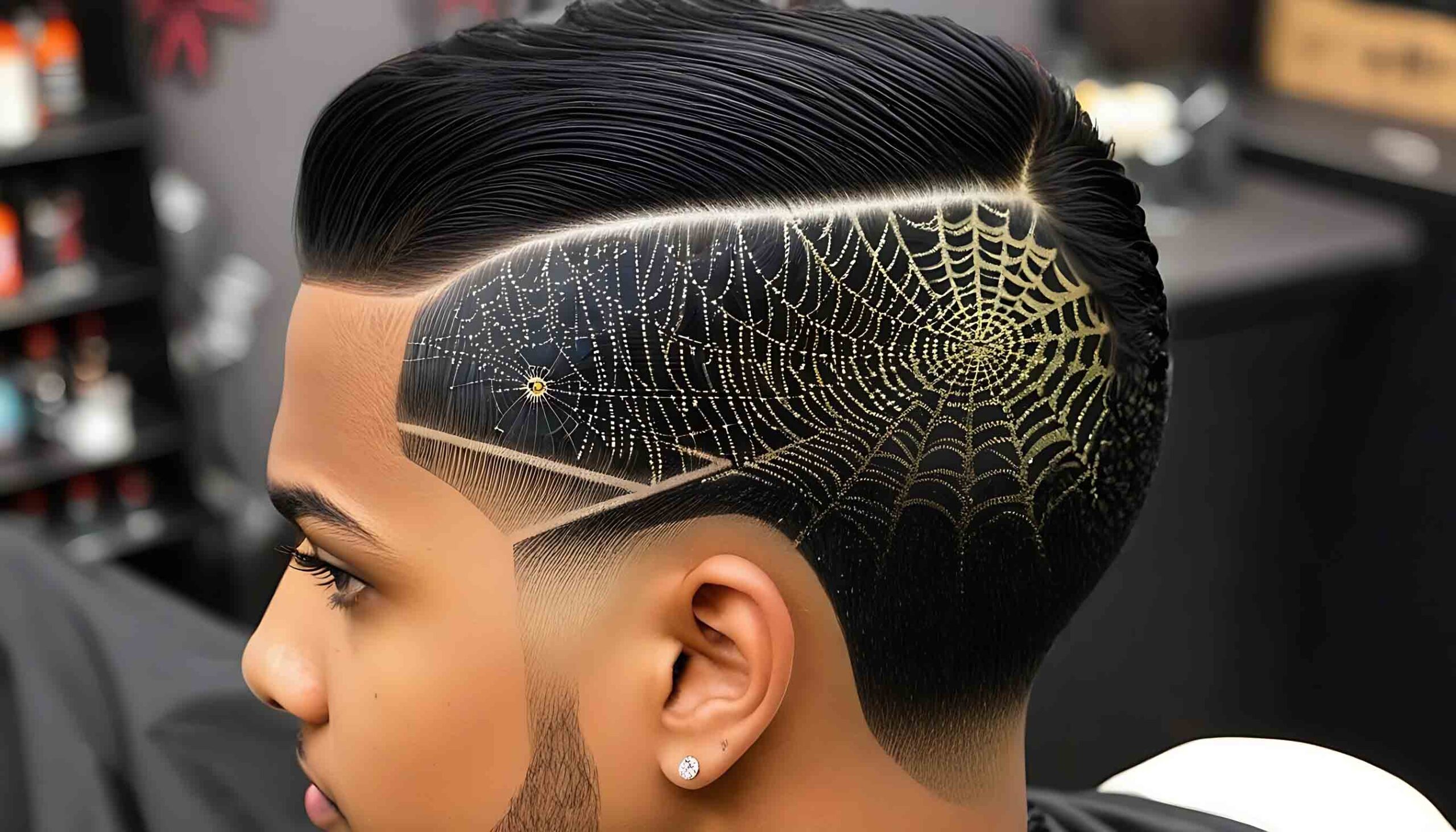A spider web design low taper haircut is an edgy, modern hairstyle for men. It features a low taper fade along the sides and back that connects to a design of sharp spider web graphics shaved into the faded hair. This guide covers how to get the cut, recommended designs, styling tips, and more.
What is Taper?
Taper refers to how the width of silk threads changes from the center of the web to the outer edges. Webs with high taper use thick silk threads in the center that rapidly narrow as they extend outwards. Webs with low taper have more consistent thread widths from center to edge.
Taper impacts two important qualities of spider web design low taper webs:
- Prey capture: High taper allows webs to better absorb the energy of impacting prey. However, low-taper webs can still effectively capture prey.
- Silk usage: High taper uses more silk to construct as thread width rapidly changes. Low taper is more efficient for the spider.
spider web design low taper design low taper are able to construct webs with varying degrees of taper through careful control of their silk extrusion. Let’s examine how taper level impacts web construction and performance.
Key Features of a Low Taper Fade
- Hair is clipped progressively shorter as it moves down from the top of the head towards the neckline.
- The taper starts lower, blending in 1-2 inches above the neckline.
- Creates a gradient fade effect minimizing scalp contrast.
- The neckline can be tapered or blocked for different looks.
- Works on short to medium-length hair.
Benefits of a Low Taper Fade
- Provides a clean, sharp edge and outline.
- The lower blend minimizes exaggerated contrast.
- Appears more subtle than a high taper fade.
- Looks great with many styles and lengths.
- Offers versatility from professional to edgy looks.
Best Face Shapes for Low Taper Fades
- Oval faces suit the contoured effect of the low taper’s gradual blend.
- The taper minimizes the narrow appearance of long-face shapes.
- Square faces benefit from the taper softening sharp edges and angles.
Design Options for Low Taper Fades
There are many options for creative designs to complement a low-taper fade haircut:
Shaved Graphics
Shaving graphics like stars, logos, and symbols into the faded sides creates an eye-catching contrast. The shortest hair around the design makes it really stand out.
Geometric Patterns
Geometric shapes like diamonds, triangles, diagonal lines, and zigzags shaved into the sides give an edgy style. They add depth when paired with the fade.
Creative Shapes
Abstract curved designs, waves, lightning bolts, and freehand shapes bring artistic style to the tapered sides.
Spider Web Graphics
One of the most popular design choices is to shave a spider web graphic into the fade. This adds intricate detail and visual interest.
Adding a Spider Web Design
Incorporating a faded spider web design is a great way to make a low-taper cut more unique:
Placement
The web design can cover the full side of the head or a smaller section halfway up the tapered side. Place it where it will stand out best with your cut.
Size
For a bold look, extend the spider web 3-4 inches across the side of the head. Or keep it smaller and more subtle at 1-2 inches wide.
Details
Shave in all details of the web for a realistic 3D look. Add a central spiral, connecting rings, and radial spokes coming from the center.
Shading
Use a razor to add varying depths to the web. Shave rings and spokes closest to the neckline the shortest, Keep layers moving up longer to add dimension.
Combining With Other Designs
You can also combine the spider web with other graphics like stars or logos for a mixed design.
Styling A Spider Web Low Taper
There are many styling options to try with a spider web low taper cut:
Short Styles
For cropped looks like a fade, crew cut, or buzz cut, style the top hair short to highlight the tapered sides.
Tall Styles
Let the top hair grow a few inches long, then style it tall. This could include spiking it up or brushing it into a pompadour or faux hawk.
Slicked Styles
Slick the top hair neatly back or to the side with pomade or gel. This creates a classy compliment to the edgy shaved design.
Natural Styles
For curlier hair, wear the top hair naturally. Allow the curls to contrast with the geometrically shaved design.
Design Enhancements
Use temporary coloring sprays or gels to make the spider web design pop even more.
Low Taper Do’s and Don’ts
To get the most out of a low taper fade haircut with a spider web design:
Do’s
- Maintain regular trims, around every 2-4 weeks, to keep the taper and design edges crisp.
- Use a color-safe moisturizing shampoo and conditioner to retain the vibrancy and health of the dyed hair.
- Protect the skin when receiving and maintaining the shaved design using shaving cream and after-shave.
- Use a beard trimmer to carefully maintain the neckline and edges around the taper.
Don’ts
- Don’t shave the design in at home if you aren’t experienced with using shaving razors. Visit an experienced barber.
- Don’t pick at or scratch the shaved design as this can cause irritation and razor bumps.
- Don’t use alcohol-based aftershaves or harsh soaps which can dry out the shaved skin.
- Don’t use dye or bleach on freshly shaved skin as this can cause irritation. Wait 2-3 days.
Benefits of the Spider Web Low Taper
There are many advantages to this creative taper fade hairstyle:
- The shaved spider web design provides detailed artwork that is eye-catching and edgy.
- It allows you to incorporate a meaningful symbol, logo, or creative image into your hairstyle.
- The smooth low taper blends subtly into the undercut graphic for a cohesive shape.
- It works well with a variety of hair lengths and styles on top for versatility.
- The intricate fading and designs showcase barbering talent and creativity.
- The geometric spider web gives off an urban, hip-hop-inspired vibe.
Constructing Low-Taper Webs
Webs with spider web design low taper require spiders to carefully regulate their silk extrusion as they build out from the center. Here are some of the techniques they use:
- Consistent pulling rate – Spiders maintain a steady rate of pulling silk from their spinnerets during web construction. This creates uniform thread widths.
- Precise silk control – Spiders can closely control the thickness of silk extruded at any given moment. This allows them to lay consistent threads.
- Single silk type – Some spiders use only one type of silk for the entire web rather than switching to thicker silk for the core threads.
| Web Component | Low Taper Technique |
|---|---|
| Radii | Steady pulling rate |
| Spiral | Precise silk control |
| Hub | Single silk type |
Table: Spider techniques used to create spider web design low taper webs.
This skillful control of silk extrusion allows spider web design low taper to conserve resources and build efficient spider web design low taper webs.
Advantages of Low Taper Webs
There are several key advantages to spider web design low taper web designs:
1. Material and Energy Efficiency
- Uses 10-30% less silk to construct.
- Requires less energy expenditure by the spider.
2. No Loss of Prey Capture Ability
- Low-taper webs are just as effective at absorbing impact energy.
- The uniform structure allows for prey interception from all angles.
3. Increased Web Stability
- The consistent thread widths prevent localized stress points.
- This results in a more durable web structure.
4. Ease of Web Repair
- Replacing individual threads is simpler with uniform silk gauges.
- Repairs blend in seamlessly in low taper webs.
By optimizing material usage and structural stability, spider web design low taper webs represent an advanced design achievement for spider architects.
Case Study: Orchard Orbweaver spider web design low taper
The orchard orb weaver spider (Leucauge venusta) provides an excellent example of low-taper web construction. These spiders create highly efficient orb webs with barely perceptible taper.
Web Architecture
Orchard orb weavers build classic orb webs with the following components:
- Frame lines – Foundational structures that anchor the web.
- Radii – The spokes that extend from the center.
- Spirals – Concentric circular threads starting from the center.
- Hub – The central location where radii meet.
An orchard orb weaver web showing minimal taper
Low Taper Techniques
Orchard orb weavers utilize the following techniques to achieve low taper:
- Slow consistent pulling – They pull silk at a steady, slow rate as they lay radial threads.
- Precise silk metering – They carefully control silk width when laying the spiral threads.
- Single silk type – They use one consistent silk for the entire web.
The combination of these approaches allows them to create a web with minimal changes in thread width from center to edge.
Efficiency Benefits
The low-taper web provides the following advantages:
- 25% less silk used – Greatly improves material cost efficiency.
- Higher stability – The uniform gauge resists damage and deformation better.
- Still captures prey – Despite using less silk, these webs reliably intercept insects.
Orchard orb weavers exemplify how low taper principles can be successfully implemented by spider web architects.
Designing Low Taper Bio-Inspired Structures
Engineers are increasingly looking to spider webs for design inspiration. Here are some ways low-taper webs can influence engineering projects:
Suspension Bridges
- Uniform load spreading from low taper increases durability.
- Less materials needed to construct can lower costs.
Fabric Textiles
- Low taper fiber layout improves tear resistance.
- More consistent material properties.
Optical Networks
- Minimal signal loss through uniform fiber diameters.
- Reduced infrastructure requirements.
By mimicking natural low-taper designs, engineers can create structures that maximize efficiency, stability, and performance.
The spider web design low taper fade is the ultimate way to transform a classic tapered cut into a stylish work of hair art. This guide covers how to get the look and important upkeep tips. It provides a creative, edgy option when you want a taper with more originality and personality. If you seek a cut that expresses your unique style, this urban-inspired design delivers. With the right taper and crisp detailing, it is sure to make you stand out.
Frequently Asked Questions
What is a taper in spider webs?
Taper refers to the change in silk thread width from the center of the web to the outer edges. Webs with high taper have thick core threads that rapidly narrow. Webs with low taper have more consistent thread widths throughout.
How do spiders create low-taper webs?
Spiders use techniques like steady pulling rates, precise silk control, and single silk type to construct webs with minimal taper. This requires more skill but allows them to use less silk.
What is a taper design?
A taper design refers to creative shapes, patterns, and imagery shaved into a tapered haircut to enhance the style. Graphics like stars, lightning bolts, spider webs, and logos can be shaved around the tapered sides and back for an artistic, edgy look.
What designs work best with low tapers?
Geometric patterns like spider webs, zigzags, and triangles as well as creative shapes like waves and swirls work great with low taper fades. Place them 1-2 inches above the neckline where the fade is sharpest for high contrast and visibility.
How long should you keep a taper design?
Maintenance is key for taper designs to keep them looking sharp. In general, getting the shaved graphics retouched every 2-4 weeks will maintain their definition as the hair grows out. More intricate designs may need freshening up every 1-2 weeks.
Can you do a taper design at home?
It’s best to have taper designs like spider webs created by experienced barbers, not at home. Professionals have the proper tools and skills to carve the designs into the fade cleanly and symmetrically. Attempting complicated shaved graphics without training risks skin irritation, razor burn, or cuts.
What hair type works best for taper fade designs?
These designs suit most hair types including straight, wavy, or curly hair. The key is keeping the hair cropped close on the sides and back with a sharp taper to allow the shaved graphics to show clearly. Thick, coarse hair provides an ideal canvas.
What is a taper design?
A taper design refers to creative shapes, patterns, and imagery shaved into a tapered haircut to enhance the style. Graphics like stars, lightning bolts, spider webs, and logos can be shaved around the tapered sides and back for an artistic, edgy look.
What designs work best with low tapers?
Geometric patterns like spider webs, zigzags, and triangles as well as creative shapes like waves and swirls work great with low taper fades. Place them 1-2 inches above the neckline where the fade is sharpest for high contrast and visibility.
How long should you keep a taper design?
Maintenance is key for taper designs to keep them looking sharp. In general, getting the shaved graphics retouched every 2-4 weeks will maintain their definition as the hair grows out. More intricate designs may need freshening up every 1-2 weeks.




